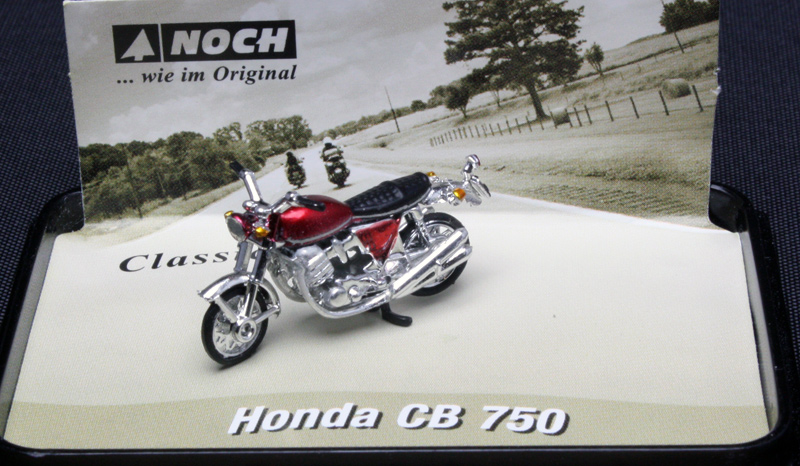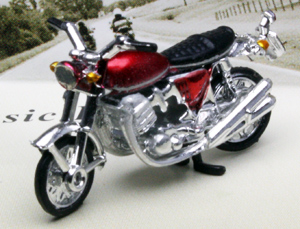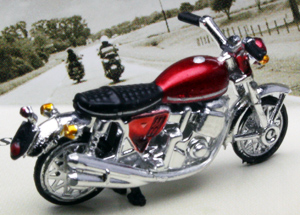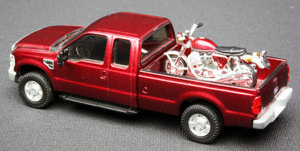Review - Noch 1/87 Scale Honda CB750 Motorcycle
Please note: The opinions expressed in our reviews are the views of the reviewer and do not necessarily reflect the views and opinions of the 1/87 Vehicle Club. model critique by Bob Johnson
Honda of Japan introduced the CB750 motorcycle to the US and European markets in 1969 after experiencing success with their smaller motorcycles. The bike was targeted directly at the US market after Honda officials, including founder Soichiro Honda, met repeatedly with US dealers and fully understood the opportunity for a larger bike than the then current offerings. The Honda CB750 offered two features not offered previously by any manufacturer, a front disc brake and a transverse straight-4 engine with an overhead camshaft, much less on a affordable production bike. These two features, along with the introductory price of US$1,495, gave the CB750 a considerable advantage over its competition, particularly its British rivals. Cycle magazine called the CB750 "the most sophisticated production bike ever" upon its introduction. Cycle World called it a masterpiece, highlighting Honda's painstaking durability testing, the bike's 120 mph (190 km/h) top speed, the fade-free performance of the braking, the comfortable ride, and excellent instrumentation. The CB750 was the first modern four-cylinder machine from a mainstream manufacturer and the term "superbike" was coined to describe it. The bike offered other important features that added to its compelling value: electric starter, kill switch, dual mirrors, flashing turn signals, easily maintained valves and overall smoothness and freedom from vibration both underway and at a standstill; later models (1991 on) included maintenance-free hydraulic valve actuation. On the other hand, the bike was difficult to get on its center stand and tended to throw chain oil onto its muffler. The bike remained in the Honda lineup for ten years, with sales totaling over 400,000 during its life span. It might be said the CB750 did for Japanese motorcycles (at least in the US) what the later Honda Civic did for automobiles of Japanese manufacture, establishing a well deserved reputation for well engineered, well assembled products with excellent serviceability and durability.
We would like to thank Michael Stephens of Walthers for the opportunity to review this model. We unconditionally recommend it as an addition to your collection whether on the shelf or on the layout for any time period from 1969 onward! A truly excellent model. |



 The translucent amber turn signals on both ends and the rear brake lights are very nice touches. The wire spoke wheels, being plastic, are necessarily over scale as are the axles and fender attaching points but do not necessarily detract from the overall presentation of the model except under magnification. In a typical collection, diorama, or layout setting they're pretty much unnoticed. The model is an extremely well proportioned representation of the prototype.
The translucent amber turn signals on both ends and the rear brake lights are very nice touches. The wire spoke wheels, being plastic, are necessarily over scale as are the axles and fender attaching points but do not necessarily detract from the overall presentation of the model except under magnification. In a typical collection, diorama, or layout setting they're pretty much unnoticed. The model is an extremely well proportioned representation of the prototype. Without specific prototype dimensions for comparison we can only say the model scales extremely well to competing models and when compared to River Point Station's outstanding 2008 Ford F-250 pickup truck (shown at left). We chose one of River Point Station's models with a similar color and the pair comes off quite well. They certainly make an attractive pair!
Without specific prototype dimensions for comparison we can only say the model scales extremely well to competing models and when compared to River Point Station's outstanding 2008 Ford F-250 pickup truck (shown at left). We chose one of River Point Station's models with a similar color and the pair comes off quite well. They certainly make an attractive pair!